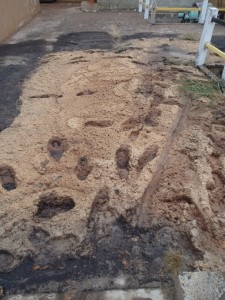In a paper mill, a remote-controlled valve used to transfer the contents of a digester (factory location: 9) opened unintentionally around 7 am during transfer of a cooking liquor (SO2-enriched ammonium bisulphite). The liquor/wood chips mix overflowed into a tub that had already received paste from another digester (location: 2). This double influx of substances caused a rise to the very high level, then the tub spilled; an effluent composed of paste, wood chips and cooking liquor flowed along the tank towards retention basins intended for droplets collected from either accelerator pumps or washing effluent. These pumps, which were not designed to suction paste, stopped working. The effluent overflowed the retention basin and entered the plant’s storm drain system before polluting the RETJONS stream. Some effluent could still be collected and channelled to a water treatment lagoon.
Water curtain-type sprinkling was installed in order to bring down the SO2 vapours. These devices however led to leaching and a dilution of discharge into the storm drain network. The mill operator activated the site’s internal emergency plan 90 min after the incident began and informed the inspection authorities for classified facilities at 8:37 am. Paper production was halted. Discharges from the site’s effluent treatment lagoon were reduced in order to limit the chemical oxygen demand (COD) flux reaching the natural environment. The RETJONS, MIDOUZE and ADOUR watercourses were all monitored: measurements were recorded at various points along them to track an array of parameters, including: dissolved O2, COD, temperature, and pH. No dead fish were reported.
The operator estimated that 20 m³ of substance had escaped from digester #9 but was unable to determine the volume of the liquor + paste mix spilling into the environment. The mix still standing near the lift pumps was recovered by a vacuum lorry and poured upstream of the mill’s treatment plant. The chips recovered in the vicinity of the plant’s screen rake were treated for later burning in the site’s biomass boiler.
To explain the causes of this accident, the mill owner presented a causal tree analysis to Classified Facilities inspectors. Among the items listed were:
- verification of automated controls ongoing at the digester 9 electrical cabinet, with detection of an anomaly in a vapour inlet valve control;
- bottom valve actuators on digester 9 and vapour valve actuators placed in alignment with one of the other two superimposed lines;
- upon reaching the tub’s very high level, automatic (and scheduled) closure of the digester 2 valve.
Moreover, inspectors questioned technicians on duty as events unfolded; their responses confirmed that:
- they had not detected any anomaly during the process;
- the opening of the digester 9 valve was interpreted as a deficiency, but nothing to this effect had been written into the alarm log;
- when they noticed the open valve on the control panel, they verified its position on-site and then from the control room programmed its closure, a step that created no issues.
The operator subsequently tested the digester 9 valve controls by installing an actuator to serve to simulate the behaviour of this component without any action actually required. The rooms containing automated controllers were locked and all mobile phones banned inside the space.




